Voges–Proskauer test

Voges–Proskauer /ˈfoʊɡəs ˈprɒskaʊ.ər/ or VP is a test used to detect acetoin in a bacterial broth culture. The test is performed by adding alpha-naphthol and potassium hydroxide to the Voges-Proskauer broth which has been inoculated with bacteria. A cherry red color indicates a positive result, while a yellow-brown color indicates a negative result.[1]
The test depends on the digestion of glucose to acetylmethylcarbinol. If glucose is being broken down, it will react with alpha-naphthol (VP reagent #1) and potassium hydroxide (VP reagent #2) to form a red color. Alpha-naphthol and potassium hydroxide are chemicals that detect acetoin.
Procedure: First, add the alpha-naphthol; then, add the potassium hydroxide. A reversal in the order of the reagents being added may result in a weak-positive or false-negative reaction.
VP is one of the four tests of the IMViC series, which tests for evidence of an enteric bacterium. The other three tests include: the indole test [I], the methyl red test [M], and the citrate test [C].[2]
VP positive organisms include Enterobacter, Klebsiella, Serratia marcescens, Hafnia alvei, Vibrio cholera biotype eltor, and Vibrio alginolyticus.[3]
VP negative organisms include Citrobacter sp., Shigella, Yersinia, Edwardsiella, Salmonella, Vibrio furnissii, Vibrio fluvialis, Vibrio vulnificus, and Vibrio parahaemolyticus.[3]
History
The reaction was developed by Daniel Wilhelm Otto Voges and Bernhard Proskauer, German bacteriologists in 1898 at the Institute for Infectious Diseases.
References
- ↑ MacFaddin, J. F. 1980. Biochemical Tests for Identification of Medical Bacteria, 2nd ed. Williams and Wilkins, Baltimore
- ↑ Bachoon, Dave S., and Wendy A. Dustman. Microbiology Laboratory Manual. Ed. Michael Stranz. Mason, OH: Cengage Learning, 2008. Exercise 15, "Normal Flora of the Intestinal Tract" Print.
- 1 2 Bergey's Manual of Systematic Bacteriology, Vol. 1. Baltimore, Williams and Wilkins, 1984.
External links
- Voges–Proskauer reaction at Merriam–Webster Online
